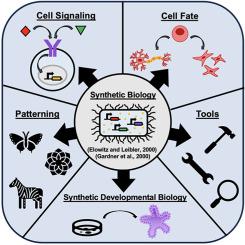Engineering development: From the repressilator and toggle switch to synthetic developmental biology
IF 2.1
3区 生物学
Q2 DEVELOPMENTAL BIOLOGY
引用次数: 0
Abstract
The publication of two landmark papers in the year 2000 demonstrated that scientists could rationally engineer genetic circuits to perform desired biological processes commonly found in nature. Elowitz and Leibler constructed a repressilator based on a negative feedback loop that showed oscillatory behavior, and the Collins lab engineered a toggle switch that was able to switch between and maintain stable states in response to external stimuli. Although built upon a long history of conceptual and technical advances in the field, both studies were nevertheless instrumental in transforming the way investigators studied complex biological processes. Rather than using a top-down approach to dissect and analyze individual components of biological processes, both research teams employed a bottom-up approach, creating genetic devices that reconstructed fundamental cellular processes—in essence, building to understand. As described in this review, this bottom-up approach was particularly transformative in the field of developmental biology where the “build to understand” approach yielded important insights into long-standing problems in developmental biology: the mechanisms underlying promiscuous, combinatorial signaling; how cells acquire a stable fate; and the emergence of complex patterns. Additionally, these papers laid the foundation for an array of technical advances that spawned the field of synthetic developmental biology and its fruitful applications to tissue engineering and regenerative medicine.

工程发展:从减压器和开关到合成发育生物学。
2000年发表的两篇具有里程碑意义的论文表明,科学家可以合理地设计基因回路,以执行自然界中常见的理想生物过程。Elowitz和Leibler构建了一个基于负反馈回路的再调节器,该回路表现出振荡行为,Collins实验室设计了一个拨动开关,能够在响应外部刺激时在不同状态之间切换并保持稳定状态。尽管这两项研究都建立在该领域概念和技术进步的悠久历史之上,但它们在改变研究人员研究复杂生物过程的方式方面发挥了重要作用。这两个研究团队并没有采用自上而下的方法来解剖和分析生物过程的单个组成部分,而是采用自下而上的方法,创造了重建基本细胞过程的遗传设备,从本质上讲,是在构建理解。正如本文所述,这种自下而上的方法在发育生物学领域具有特别的变革意义,其中“构建以理解”的方法对发育生物学中长期存在的问题产生了重要的见解:混杂、组合信号的潜在机制,细胞如何获得稳定的命运,以及复杂模式的出现。此外,这些论文为一系列技术进步奠定了基础,这些技术进步催生了合成发育生物学领域,并在组织工程和再生医学方面取得了丰硕的应用。
本文章由计算机程序翻译,如有差异,请以英文原文为准。
求助全文
约1分钟内获得全文
求助全文
来源期刊

Developmental biology
生物-发育生物学
CiteScore
5.30
自引率
3.70%
发文量
182
审稿时长
1.5 months
期刊介绍:
Developmental Biology (DB) publishes original research on mechanisms of development, differentiation, and growth in animals and plants at the molecular, cellular, genetic and evolutionary levels. Areas of particular emphasis include transcriptional control mechanisms, embryonic patterning, cell-cell interactions, growth factors and signal transduction, and regulatory hierarchies in developing plants and animals.
 求助内容:
求助内容: 应助结果提醒方式:
应助结果提醒方式:


